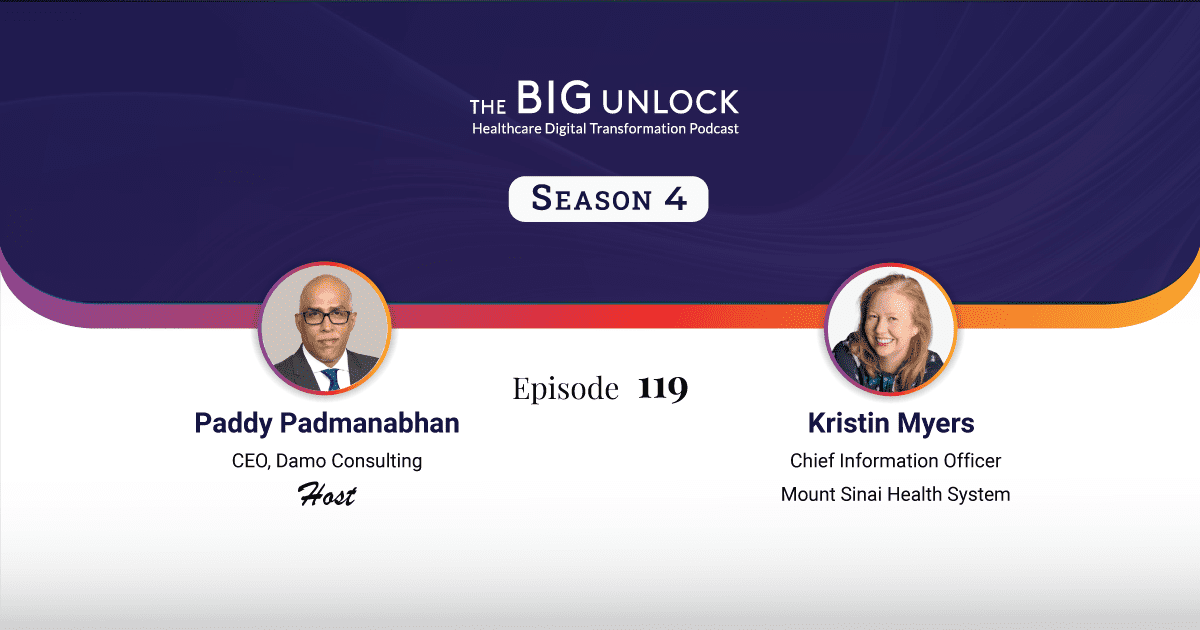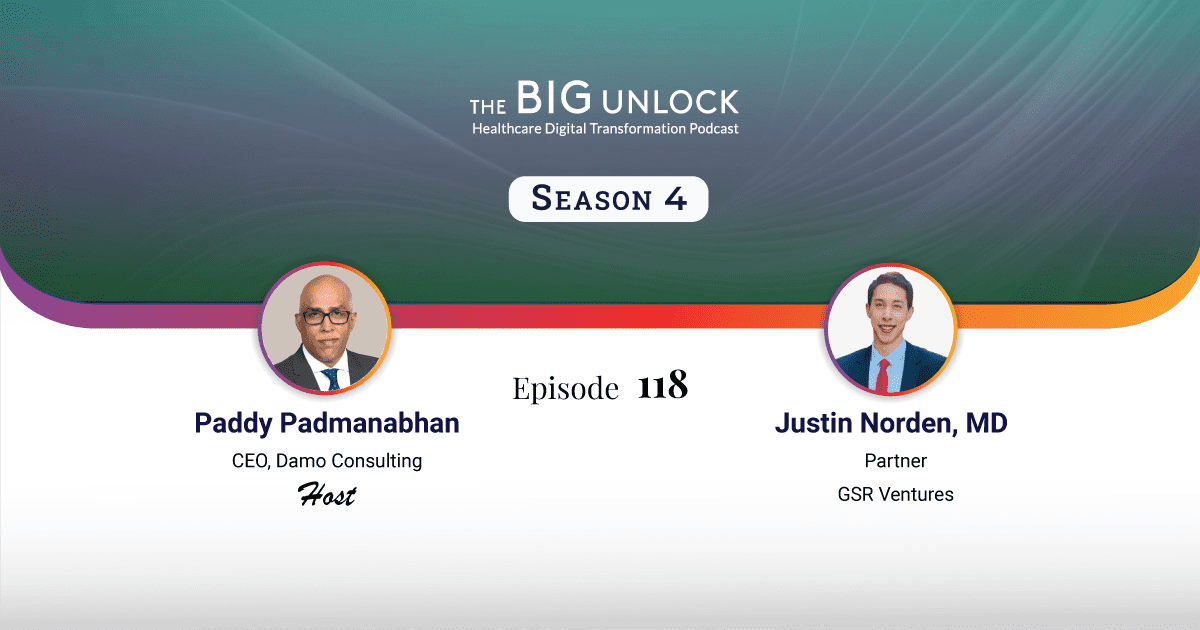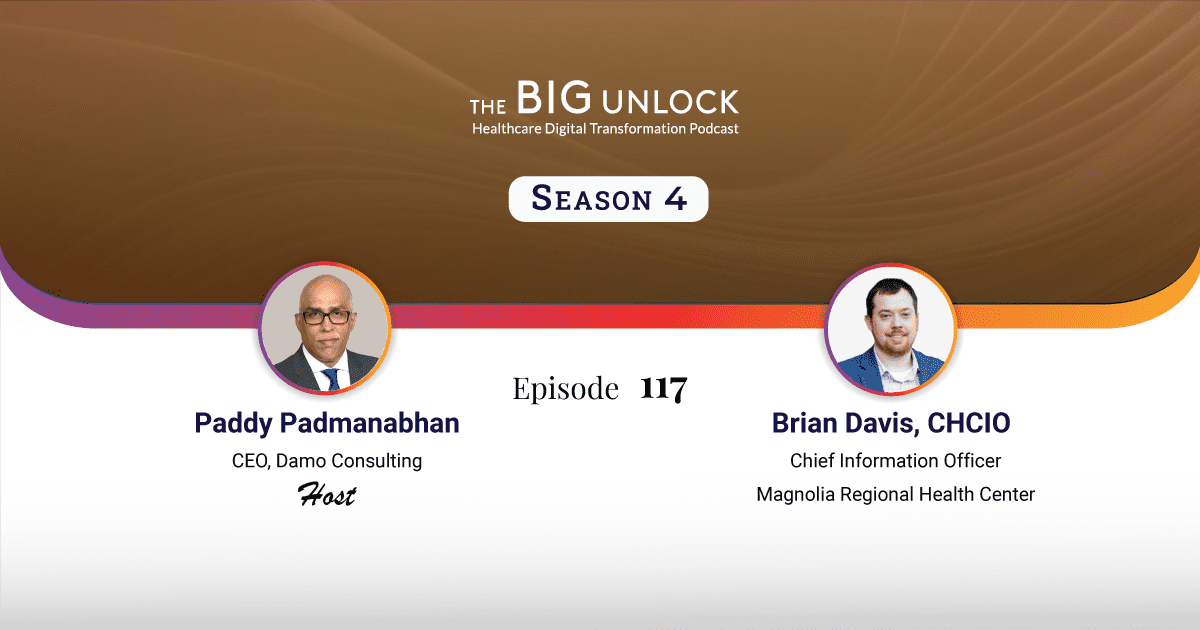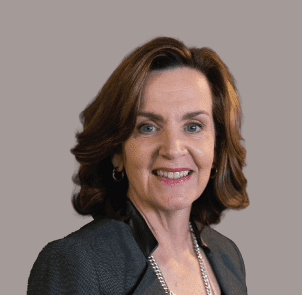Season 4: Episode #119
Podcast with Kristin Myers, Chief Information Officer, Mount Sinai Health System
"The healthcare industry is moving away from point solutions"
 Hosted by Paddy Padmanabhan
Hosted by Paddy Padmanabhan 
Share
In this episode, Kristin Myers, CIO of Mount Sinai Health System, discusses topics related to the digital transformation journey at Mount Sinai – telehealth and access, digital patient experiences, remote care, home health, and more. Kristin also talks about the multi-year cloud transformation journey at Mount Sinai with Microsoft and the key themes that her team is focused on this year.
Kristin discusses why telehealth and virtual health are critical components of healthcare in the future and provides insights into how she makes technology choices in a rapidly changing landscape. She reflects on the changing role of the CIO in healthcare and why she decided to rename the IT organization. She concludes with advice for startups looking to partner in Mount Sinai’s digital transformation journey. Take a listen.
Show Notes |
||||
| 01:51 | What does your digital strategy at Mount Sinai look like? Can you share your top priorities for enterprise digital transformation? | |||
| 05:21 | Please tell us a little bit about your recent announcement about a multi-year cloud transformation journey. What led you to do it and how is that going to enable you to accomplish all the goals that you just talked about? | |||
| 08:24 | A large part of your application's estate is going to the cloud. Are you moving your EHR, for instance? Can you talk a little bit about what all that means? | |||
| 09:46 | What does it feels like to be one of the pioneers at the front end of this cloud migration wave from the point of view of health systems and health care providers? Are we in very early stages of cloud migration as a sector, as providers? | |||
| 12:07 | Tell us about your experience in the investments you've made in your telehealth program. Where do you see yourself today with regards to your patient population and provider community adopting it? | |||
| 14:32 | What are the challenges you've had to overcome and what are your immediate priorities as it relates to the next stage of evolution of this hybrid model of care? | |||
| 15:54 | Can you talk to us about how you approach the platform choices to create this seamless consumer experience? | |||
| 23:14 | Tell us about your high-level approach to data and analytics. | |||
| 26:35 | What are your thoughts on automation technologies and where you see them being applied in your context? | |||
| 30:47 | What's your advice to the startups if they want to approach Mount Sinai to be a partner in your journey? | |||
| 32:53 | Why is the industry moving away from point solutions? | |||
About our guest
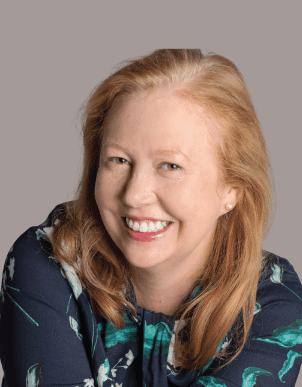
Kristin Myers is a visionary leader who is steering IT transformation efforts to align and support the strategic goals of Mount Sinai Health System. As Executive Vice President, Chief Information Officer and Dean for Information Technology, her main objectives are to drive agility in the department to support the health system’s mission of clinical care, research, and education; optimize the department’s operations; and enable the Health System for digital change.
Ms. Myers joined the Health System as a Director of IT in 2004. Her many key accomplishments include leadership of the Epic clinical and revenue cycle implementations and the organization’s transition to ICD10 coding, and establishment of the IT Program Management Office and Change Management as a discipline within IT in 2009.
Ms. Myers is a nationally acclaimed healthcare leader. She was chosen as one of Crain New York’s Notable in Health Care list in 2021, selected to join the 2021 HIMSS Future50 Community, awarded the Modern Healthcare 2021 Top 25 Women in Healthcare honoree, and listed as 102 Women to Watch in Health IT in 2020. Under Ms. Myers’ leadership, Mount Sinai was awarded the prestigious Health Information and Management System Society (HIMSS) 2012 Enterprise Davies Award of Excellence for its electronic record implementation to improve quality of care and patient safety. Most recently, Mount Sinai Morningside and Mount Sinai West received HIMSS Stage 7, the highest level of technology adoption.
Before joining Mount Sinai, Ms. Myers worked at Cap Gemini, Ernst and Young, and the Cerner Corporation in Australia. She holds an Executive Master of Public Health from Columbia University and an Executive Chief Information Security Officer certification from Carnegie Mellon. She has been designated a Fellow of HIMSS; has received certifications in Program Management (PgMP), Project Management (PMP, Prince 2), and AIM Change Management; and is a Certified Professional in Health Information and Management Systems.
Q. Kristin, thank you so much for joining us, today, and welcome to the show! Please tell us a little about Mount Sinai.
Kristin: The Mount Sinai Health System was created in 2013 when the Mount Sinai Medical Center merged with Continuum Health Partners. We have eight hospital campuses in New York, and the Icahn School of Medicine. The Mount Sinai Medical Center has had a very long history. We started out in 1820 with the New York Eye and Ear Infirmary, and over time have accumulated hospitals. Our main hospital was founded in 1852. We have around $9.3 bn in revenues, 43,000 employees, and over 7,000 physicians — a very large academic health system in New York.
Q. What does your digital strategy at Mount Sinai look like? Can you share your top priorities for enterprise digital transformation?
Kristin: Everyone is aware of the pace at which technology and digital is transforming health care. It’s just accelerated exponentially, especially with COVID. Given the number of ways of doing business, today, we have to shift to digital workforce, embrace new digital channels in which we can engage our patients and, adopt innovative ways to provide care. My goal has been to reinvent and transform technology and digital as an organization and drive real change in culture so that its innovative and resilient within the department. For me, then, there are three key themes I’m really focused on: first, is customer service, and being able to serve and support and enable our stakeholders. The second is innovation, that must be done at-scale, at the enterprise-level with focus on differentiation, new ways of working, and new business models after which we must examine new opportunities to drive change and transformation.
The third is around digital, where we think about our patient and employee experiences within an overall digital strategy and roadmap. The focus, then, is around digitally enabling Mt. Sinai as the preferred destination for our community. It’s important to anticipate needs so that we can provide that equitable and seamless experience to everyone we interact with.
Also, when I think about digital, I go back to a framework with three key components: digital business models to reimagine the way we do business with digital and technology capabilities; digital experiences that focus on the experiences that our patient and employees are having; digital core, which is around our operating model that revolves around people, process, and technology.
We’ve really taken a step back to think about how we can devise a more experience-led, integrated approach so that we’ve got a digital roadmap that prioritizes the identified key opportunities, understand what the technology implications and changes are that need to be made to support that, and then, incorporate other considerations like program governance, change management before activating it as a whole enterprise-wide.
Q. Mount Sinai has made a recent announcement regarding a multi-year cloud transformation journey. What is its scope and scale? How is that going to enable you to accomplish all of these goals you’ve mentioned?
Kristin: I’ve looked at each functional area in the technology organization — the data centers, our business continuity, and disaster recovery plans etc. Question is, how do we transform that? When I see our target operating model over the next five years, it means that we have to have a Cloud transformation, need to mature our capabilities around business continuity and disaster recovery and then, provide that modern and scalable platform in which we can grow with the Health System.
We’ve partnered Microsoft, our cloud provider and Accenture, our system integrator to really execute on that Cloud and data center transformation and support innovation efforts to enable new business and growth models that can drive research and A.I. efforts. These measures will support an academic medical center with more modern technology infrastructure and increased security, that will improve our uptime recovery and enhance agility while avoiding significant costs to complete facilities, remediation and hiring of additional data center and facility staff.
Just to give you a sense, we have 13 data center and server rooms across the Health System. That’s significant and being able to reduce that to at least one on-prem, eventually, would be good. It’d be great to have none, but one at least will significantly reduce our costs and improve our ability to recover from outages that would impact revenue, patient care and operations. We get to have that geographic diversity and failover capabilities that are in the Cloud, too. This, then, was a large step forward that was necessary for us to do as an organization.
Q. Are you moving your EHR, for example? Can you talk a little about what that means?
Kristin: We’ve gone through our application portfolio and reviewed which applications would be a light lift to move to the Cloud versus a heavy lift. Now, there are some applications that, today, are not ready to be moved to the Cloud, so, we’ll have to work with those vendors over a period of the next few years.
As it relates to the EHR, our intent is to move Epic to the Cloud. We’ll start with the training and testing environments, and disaster recovery before we even move to some of our larger environments, and ultimately, production. But, we’re working very closely with Epic as well as Microsoft and Accenture to make sure that that transition will be successful over the coming years.
Q. You would be one of the pioneers, you know, and at the front end of this cloud migration wave from the point of view of health systems and health care providers. What does that feel like?
Kristin: We’ve seen the financial services and other sectors that have already made this transition. When I speak with other CIOs it’s clear that everyone’s looking at Cloud and Software as a Service. Many applications that are already in the portfolio are SaaS. So, CIOs are taking a gradual approach.
But it also depends on the investments that have been made historically, in data centers. Some CIOs have built their data centers from the ground-up and invested significant amounts of money in doing that. For us, it was a very different picture when we started looking at our investments and how many data centers we had. Overall, the business case for us to move to the Cloud really made sense. For other organizations it may not make sense at this time. But, taking that gradual approach might.
Q. Going back to some of your digital transformation themes, one of the big one of the big shifts in the last couple of years has been towards telehealth models. Do share your experience with this. Where do you see yourself, today, with regard to your patient population at Optum and your own provider community?
Kristin: We’d developed the infrastructure prior to Covid and had a number of physicians experimenting with telehealth. But it was not necessarily part of the model of care, across the Health System. When COVID hit, we were able to scale very quickly and we saw large volumes with telehealth, too. Today, as we see with the trends of other health systems, it’s dropped, but it’s been very steady — around 15 to 20% of overall ambulatory volume, which is significant. Investments will continue in this.
We’ve made a lot of investments around tele consultations in the in-patient setting, too. And this has resulted in savings in the cost of care leading to alleviation of clinical capacity constraints by diverting patients from higher acuity sites of care. That will also continue to be an area that we invest in. For us, access is really the center of our digital roadmap and a core priority, so, ensuring that we have virtual health as a key pillar that we continue to invest in, will always be important.
Q. We’re now settling towards a hybrid model of care — a mix of in-person visits complemented by virtual visits. Here, the quality of the experience becomes very important. Can you talk about the seamlessness this entails? Also, what are the challenges you’ve had to overcome to get to the next stage of evolution of this hybrid care model?
Kristin: It’s important to make sure that the platforms that we’re utilizing are ones that integrate very well with the EHR. We’ve used a variety of tools that have integrated well with Epic. We’re currently looking at Zoom as part of our overall unified communication strategy. They have been integrated with Epic and may be a good vendor long-term for us to work with. Considering that, we’re looking at them more broadly across the organization.
Q. When you look at your tool and platform choices, there is a plethora of options out there. How you approach these platform choices to create a seamless patient experience? Do you have an Epic-first policy to go with or do you evaluate tools on a case-by-case basis?
Kristin: I always think about the overall Epic roadmap because it is one about foundational platforms similar to maybe ServiceNow, Salesforce and ERP. It’s important for you to understand what the roadmap is and what functionality is coming in the next 2-3 years. There are so many gaps with any of these foundational tools that you always need to be looking at other solutions to complement them.
My approach is looking at the solution in the context of experience, specifically, for our patients and employees. That’s key. How does the platform integrate with some of the foundational products like an Epic is important, too. It’s equally crucial to be really intentional about what the roadmap looks like — Are we implementing a product or point solutions for 2-3 years before it becomes part of the roadmap of Epic? Will we decommission it when Epic releases this function and adopt that? It’s methodical but Epic tools need to be able to have the functionality of these point solutions, and that’s some of the challenges over time.
Q. I think that’s a very valuable and interesting input for, especially for startup founders listening to this podcast Let’s now talk about the remote care and home health part of digital transformation. Can you tell us about your own experience and some of the programs that you’ve got going in remote monitoring and home health spaces?
Kristin: This is a space our teams are working on, specifically with Mount Sinai Health Partners, in population health. Currently, we have approximately 2,000 patients enrolled in remote patient monitoring, specifically around, an area like blood pressure. It’s a priority for us and we need to be able to expand these programs. In the meantime, we’re looking at possible foundational partners overall, for remote patient monitoring. There are a number of vendors since it’s a crowded marketplace! But to have one vendor for many of the capabilities while that’s ideal, I don’t think we’ll get to a 100% of the capabilities with one. However, if we can get a vast majority with one, that would be helpful. I’m interested to hear what your thoughts are about this space.
Q. I see that home health is definitely going to be the default mode of care in the next 5-10 years for a large part of one’s routine and chronic care needs. When one needs to come into the hospital, one comes to the hospital. The big investments will come in from companies like Amazon who will define the space in some way going forward because they’re approaching the market from a different standpoint. The technologies that are emerging can make it a viable reality. So, whether it is remote monitoring, where you can use the sensors and monitors and devices to pull the data and intervene appropriately or whether it is voice recognition technologies, each one will enable the shift towards more of a home health model.
Kristin: What are you seeing with the vendor marketplace? From our perspective, it just seems very crowded. There are also many of the vendors who do not want to integrate with the foundational system.
Q. There is a lot of tension between a foundational system, Epic in particular, I’d say, and the vendor community out there at large, and that’s got to do with the source of the data. How do you get the data to drive the experiences? While the vendor landscape is thriving, it’s also very fragmented so it’s very hard to see who’s going to make it and who is not. There’re a number of things in play there — Integration with Epic HER, EHR and transaction systems, the workflows, how do you really take care of people at home? How do you create a seamless model where they can come into the hospital, go back, do a tele-visit, be taken care of at home etc. There’re al these that need to come together, seamlessly. I think, we’re still some distance away from creating that seamlessness.
Q. Mt Sinai’s got the Hasso Plattner Institute for Digital Health. You have significant research-related data and an analytics program. Tell us about your high-level approach to data and the analytics program.
Kristin: About two years ago, we took a step back and looked at all of our data assets across the Health System. Being a research organization, we have a number of them. But while we have a lot of data assets, we needed to create an enterprise data hub. We’ve been making a lot of investments, looking at data governance and data stewardship, making sure that when we’re providing data to either our researchers, educators or faculty, that it is of high quality. That’s been an area of focus.
We’ve been ensuring that our data is accessible and can be sent to our payers. There are significant incentives that we get owing to this like any health care organization, so, being able to create that real-time data feeds to the payers has also been an area of focus.
Predictive modeling has also been critical for us. We have an amazing clinical data science team that develops predictive models and integrates them with Epic. We’re looking at ways in which, potentially, we could spin-off some of the work that is being done for it has a very large outline and tremendous operational impact in really improving quality and outcomes. So, there’s a lot of exciting stuff going on here, but, predictive modeling is probably one area that stands out to me.
Q. You mention data quality. I often hear about the fragmentation of data sources, devices and absence of a standard data model. Is it fair to say getting data in a standardized format that can be wrangled into a usable dataset is a significant challenge?
Kristin: It is a challenge and something that we’re working through as part of our overall enterprise data hub strategy.
Q. Let’s talk about the acute labor shortage economy-wide that we’re experiencing and the automation technologies that are stepping into the breach in some way. Can you share your thoughts on automation technologies and where you see them being applied in your context?
Kristin: Automating administrative tasks through Robotic Process Automation can reduce human workload and realize cost savings. It can increase employee satisfaction and retention rates because it takes some of the very simple and basic work and automates that so employees can focus on the more complex work. We have an RPA team that works with the business and looks to identify, evaluate, and execute some process automation opportunities.
We’re also investing in some conversational AI to free-up capacity, there.
The IVR is also a tool to automate administrative tasks, improve employee experience and prevent burnout. That’s a real problem that we’re seeing across the board, whether it’s the clinical teams — our physicians and nurses – or frankly, everyone in health care.
Q. You’re the CIO of one of the largest health systems in the country with a long career in technology. How has the role of a CIO changed over the last few years? What are the big leadership qualities expected of CIOs, today? How is this different from what it might have been before?
Kristin: It’s so different. If you asked people what the role of the CIO was pre-COVID, you probably got different responses. So, it goes back to how technology and digital innovation has just accelerated. It’s no longer about managing IT anymore. It’s about leveraging technology and the digital to enable business, drive growth and create value. Being a partner at the executive leadership table means I can influence and help formulate and enable the business strategy of the health system and then, execute on those priorities to really achieve the business outcomes.
So, it’s a huge change in mindset and how people view the IT function, which is why I renamed our function — Digital and Technology Partners. This represents our vision, value, culture, and contributions to the health system.
If we say IT, it doesn’t necessarily appeal to a new digital generation either, right? We want to be able to try and retain and recruit technology talent. This will continue to be an ongoing challenge. Everyone’s aware of the great resignations, so, being able to attract talent is really important. So, it’s a very different role.
Q. There’s a lot of folks listening to this podcast who are from the technology startup ecosystem. What’s your advice to them if they want to approach Mt. Sinai to be a partner in your journey?
Kristin: Be clear on the value proposition and the business model. We’re a large, mission-driven organization and our operating margins are pretty tight. So, we’re always looking for sustainable business models with measurable impact. Some companies will offer a “free pilot before you scale,” but, nothing is free because it means that resources and teams are being redirected and all of this comes at a cost to the organization. Understand that, even if that offer is made, it still requires a comprehensive review.
I’d encourage these startup organizations to think about how the industry’s moving away from point solutions. So, if you’re going to pitch that, you need to ensure that you’re articulating how to address capability and experience gaps and how that could integrate into our foundational products, such as, Epic, the ERP, etc. Health care organizations are going to start focusing more on the patient and employee experiences, so, having so many digital health vendors that don’t integrate with one another, only dissatisfies our patients and employees.
Q. This may be a topic for a much deeper conversation but I’d like your thoughts on is this lack of integration causing the friction that you’re alluding to and is that why the industry is moving away from point solutions?
Kristin: I believe so, because we have frictionless experiences in our everyday life with other industries. With health care, there’s a lot of friction. Some of this is really down to the lack of a focus on that experience. If there are so many vendors that aren’t interoperable and providing that seamless experience to patients, it is dissatisfying, right?
We hope you enjoyed this podcast. Subscribe to our podcast series at www.thebigunlock.com and write to us at [email protected]
Disclaimer: This Q&A has been derived from the podcast transcript and has been edited for readability and clarity
Recent Episodes
About the host
Paddy is the co-author of Healthcare Digital Transformation – How Consumerism, Technology and Pandemic are Accelerating the Future (Taylor & Francis, Aug 2020), along with Edward W. Marx. Paddy is also the author of the best-selling book The Big Unlock – Harnessing Data and Growing Digital Health Businesses in a Value-based Care Era (Archway Publishing, 2017). He is the host of the highly subscribed The Big Unlock podcast on digital transformation in healthcare featuring C-level executives from the healthcare and technology sectors. He is widely published and has a by-lined column in CIO Magazine and other respected industry publications.

